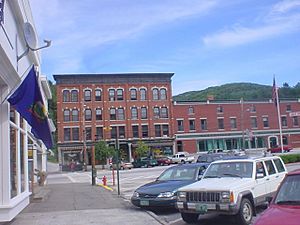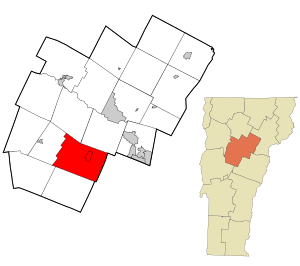Northfield, Vermont facts for kids
Quick facts for kids
Northfield, Vermont
|
|
|---|---|

Depot Square, Downtown Northfield
|
|
| Motto(s):
"Where the Good Life Begins"
|
|

Location in Washington County and the state of Vermont
|
|
| Country | United States |
| State | Vermont |
| County | Washington |
| Chartered | 1781 |
| Incorporated | 1855 |
| Communities |
|
| Area | |
| • Total | 43.6 sq mi (113.0 km2) |
| • Land | 43.5 sq mi (112.7 km2) |
| • Water | 0.1 sq mi (0.3 km2) |
| Elevation | 735 ft (441 m) |
| Population
(2020)
|
|
| • Total | 5,918 |
| • Density | 135.64/sq mi (52.372/km2) |
| Time zone | UTC−5 (EST) |
| • Summer (DST) | UTC−4 (EDT) |
| ZIP Codes |
05663 (Northfield)
05664 (Northfield Falls) |
| Area code(s) | 802 |
| FIPS code | 50-50275 |
| GNIS feature ID | 1462163 |
Northfield is a town in Washington County, Vermont, United States. It sits in a valley surrounded by the Green Mountains. Since 1866, it has been home to Norwich University, a well-known college.
The town includes the village of Northfield, where more than half of the people live. In 2020, about 5,918 people called Northfield home.
Contents
History of Northfield
Northfield was officially created in 1781. It was named after a town called Northfield, Massachusetts.
Early Settlements and Growth
Between 1785 and the 1820s, people from Connecticut, Massachusetts, and other parts of Vermont settled here. They created four different villages: South Village, Center Village, Factory Village, and Northfield Falls.
South Village was the first to grow, with many small businesses. Center Village became the main social and political hub. It had the first post office and churches. Factory Village, named for a woolen mill, developed next. Northfield Falls also grew by the late 1820s.
Changing Industries
At first, Northfield's economy was based on farming and trading goods. Making potash (a type of ash used in soap and fertilizer) was important until about 1814. After that, Elijah Paine's woolen mill became a major employer.
Wool prices dropped in the 1840s. However, Charles Paine, Elijah's son, brought the Vermont Central Railroad to town. He made Northfield the railroad's main office, and many people worked for the railway. In 1852, the railroad changed owners and slowly moved its operations away. This caused Northfield's population to shrink.
Village Incorporation and New Industries
The railroad's arrival in the 1840s made Factory Village the busiest part of town. People wanted better services. So, on November 14, 1855, Factory Village officially became the separate Village of Northfield.
Later, slate quarrying (digging for slate rock) brought a temporary boost to the economy in the 1860s and 1870s. Norwich University moved to Northfield in 1866. In 1889, the first granite shed was built. More sheds followed, and by World War I, over 525 people worked in the granite industry. Over time, the granite business faced problems, and most plants closed. The last one shut down in 1999.
Geography and Climate
Northfield covers about 113 square kilometers (43.6 square miles). Most of this is land, with a small amount of water.
The very center of Vermont is located within Northfield. You can find markers for both the geographic and magnetic centers on the Norwich University campus.
Northfield's Climate
Northfield has a humid continental climate. This means it has warm summers and cold, snowy winters.
| Climate data for Northfield, Vermont (1991–2020 normals, extremes 1887–2018) | |||||||||||||
|---|---|---|---|---|---|---|---|---|---|---|---|---|---|
| Month | Jan | Feb | Mar | Apr | May | Jun | Jul | Aug | Sep | Oct | Nov | Dec | Year |
| Record high °F (°C) | 68 (20) |
71 (22) |
82 (28) |
90 (32) |
93 (34) |
96 (36) |
98 (37) |
97 (36) |
95 (35) |
85 (29) |
76 (24) |
68 (20) |
98 (37) |
| Mean daily maximum °F (°C) | 28.7 (−1.8) |
32.4 (0.2) |
40.9 (4.9) |
53.8 (12.1) |
68.0 (20.0) |
76.3 (24.6) |
80.9 (27.2) |
79.2 (26.2) |
72.4 (22.4) |
58.8 (14.9) |
45.6 (7.6) |
34.5 (1.4) |
56.0 (13.3) |
| Daily mean °F (°C) | 17.5 (−8.1) |
19.9 (−6.7) |
28.8 (−1.8) |
41.5 (5.3) |
54.3 (12.4) |
63.4 (17.4) |
68.0 (20.0) |
66.1 (18.9) |
58.9 (14.9) |
46.7 (8.2) |
35.8 (2.1) |
24.5 (−4.2) |
43.8 (6.6) |
| Mean daily minimum °F (°C) | 6.3 (−14.3) |
7.4 (−13.7) |
16.7 (−8.5) |
29.1 (−1.6) |
40.7 (4.8) |
50.6 (10.3) |
55.0 (12.8) |
53.1 (11.7) |
45.5 (7.5) |
34.7 (1.5) |
25.9 (−3.4) |
14.5 (−9.7) |
31.6 (−0.2) |
| Record low °F (°C) | −35 (−37) |
−39 (−39) |
−23 (−31) |
−1 (−18) |
18 (−8) |
27 (−3) |
33 (1) |
27 (−3) |
16 (−9) |
8 (−13) |
−14 (−26) |
−41 (−41) |
−41 (−41) |
| Average precipitation inches (mm) | 3.21 (82) |
2.65 (67) |
3.07 (78) |
3.66 (93) |
3.93 (100) |
4.43 (113) |
5.04 (128) |
3.79 (96) |
3.29 (84) |
4.62 (117) |
3.35 (85) |
3.70 (94) |
44.74 (1,136) |
| Average snowfall inches (cm) | 17.9 (45) |
15.0 (38) |
13.9 (35) |
3.3 (8.4) |
0.0 (0.0) |
0.0 (0.0) |
0.0 (0.0) |
0.0 (0.0) |
0.0 (0.0) |
0.3 (0.76) |
4.1 (10) |
21.3 (54) |
75.8 (193) |
| Average precipitation days (≥ 0.01 in) | 10.4 | 8.2 | 8.3 | 10.2 | 12.1 | 12.9 | 11.3 | 10.0 | 8.7 | 11.4 | 9.4 | 11.4 | 124.3 |
| Average snowy days (≥ 0.1 in) | 7.3 | 5.9 | 4.5 | 1.2 | 0.0 | 0.0 | 0.0 | 0.0 | 0.0 | 0.3 | 2.2 | 6.7 | 28.1 |
| Source: NOAA | |||||||||||||
Population and People
| Historical population | |||
|---|---|---|---|
| Census | Pop. | %± | |
| 1800 | 204 | — | |
| 1810 | 426 | 108.8% | |
| 1820 | 690 | 62.0% | |
| 1830 | 1,412 | 104.6% | |
| 1840 | 2,013 | 42.6% | |
| 1850 | 2,922 | 45.2% | |
| 1860 | 4,329 | 48.2% | |
| 1870 | 3,410 | −21.2% | |
| 1880 | 2,836 | −16.8% | |
| 1890 | 2,628 | −7.3% | |
| 1900 | 2,855 | 8.6% | |
| 1910 | 3,226 | 13.0% | |
| 1920 | 3,096 | −4.0% | |
| 1930 | 3,438 | 11.0% | |
| 1940 | 3,601 | 4.7% | |
| 1950 | 4,314 | 19.8% | |
| 1960 | 4,511 | 4.6% | |
| 1970 | 4,870 | 8.0% | |
| 1980 | 5,435 | 11.6% | |
| 1990 | 5,610 | 3.2% | |
| 2000 | 5,791 | 3.2% | |
| 2010 | 6,207 | 7.2% | |
| 2020 | 5,918 | −4.7% | |
| U.S. Decennial Census | |||
In 2000, Northfield had 5,791 people living in 1,819 households. About 32.4% of these households had children under 18. Many households (53.5%) were couples living together.
The population was spread out in terms of age. About 19.4% were under 18 years old. A large group (27.2%) were between 18 and 24, likely due to the university. The average age in Northfield was 30 years.
Education in Northfield
Norwich University is a special college in Northfield. It's a senior military college, meaning it combines military training with regular studies. It has students on campus and a large online program for graduate degrees.
Northfield is part of the Paine Mountain Union School District. The town has two schools for younger students:
- Northfield Elementary School
- Northfield Middle/High School
Famous Landmarks
Northfield is known for its five covered bridges. These old wooden bridges are very scenic.
- Three bridges—Upper Cox, Lower Cox, and Northfield Falls—cross Cox Brook and Dog River close to each other.
- Just below them, the Slaughterhouse Covered Bridge also crosses the Dog River.
- The Stony Brook Covered Bridge, built in 1899, is the last of its kind on a Vermont public road.
Local News
The local newspaper is called the Northfield News & Transcript. It comes out every week and was started in 1878.
Economy of Northfield
The biggest employer in Northfield is Norwich University. After that, Cabot Hosiery Mills is another major employer.
Transportation in Northfield
Bus Services
Northfield has a bus service provided by the Green Mountain Transit Agency. Route 93 runs between Northfield and Montpelier, which is the state capital.
Main Roads
 Vermont Route 12 connects Northfield to Montpelier and Brookfield.
Vermont Route 12 connects Northfield to Montpelier and Brookfield. Vermont Route 64 connects Northfield to Williamstown.
Vermont Route 64 connects Northfield to Williamstown.
Notable People from Northfield
Many interesting people have connections to Northfield:
- Ida A. T. Arms – A missionary, educator, and leader in the temperance movement.
- Henry M. Bates – He served as the Vermont State Treasurer.
- Murdock A. Campbell – A United States Army Major General and Adjutant General for the Vermont National Guard.
- John P. Connarn – He was a member of the Vermont House of Representatives, the Vermont Attorney General, and a judge.
- Beatrice Corliss – The first woman mayor of Gloucester, Massachusetts.
- Reginald M. Cram – A United States Air Force Major General and Adjutant General of the Vermont National Guard.
- Joseph H. Denny – He was the Speaker of the Vermont House of Representatives and President pro tempore of the Vermont State Senate.
- Alonzo Jackman – A professor at Norwich University and a Brigadier General in the Vermont Militia during the American Civil War.
- Hollis Latham – A Wisconsin state legislator and farmer, born in Northfield.
- William B. Mayo – A medical doctor and politician.
- George Nichols – He was the Secretary of State of Vermont and president of Norwich University.
- Charles Paine – He was the president of the Vermont Central Railroad and the 15th governor of Vermont.
- Charles Plumley – A congressman from Vermont.
- Frank Plumley – Also a congressman from Vermont.
- Francis V. Randall – An officer in the Union Army during the American Civil War.
- Susanne R. Young – She became the Vermont Attorney General in June 2022.
Images for kids
See also
 In Spanish: Northfield (Vermont) para niños
In Spanish: Northfield (Vermont) para niños



